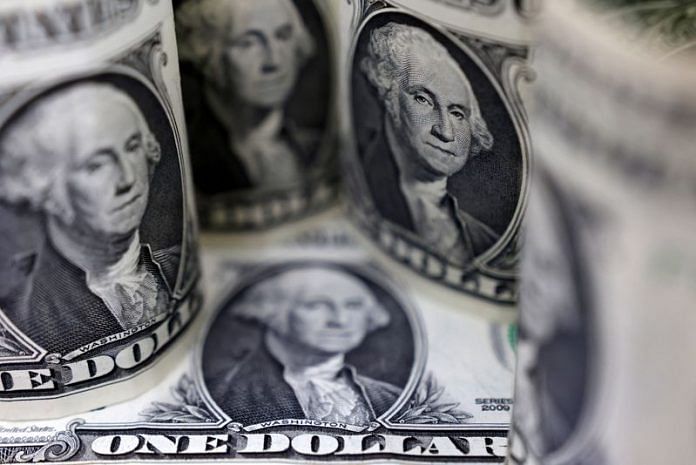By Gertrude Chavez-Dreyfuss and Harry Robertson
NEW YORK/LONDON (Reuters) -The U.S. dollar rallied on Tuesday after falling overnight to its lowest against the euro, sterling and Swiss franc since mid-March, as investors consolidated gains in other currencies ahead of a key nonfarm payrolls report later this week.
The greenback, however, pared gains against a basket of currencies led by the euro and extended losses versus the yen after U.S. job openings fell more than expected in April to the lowest in more than three years, according to the Job Openings and Labor Turnover Survey, or JOLTS report.
Job openings, a measure of labor demand, were down 296,000 to 8.059 million on the last day of April, the lowest level since February 2021.
Market participants had their focus on the JOLTS data, ahead of Friday’s U.S. job report, which is expected to show new jobs created of 185,000 in May, up from 175,000 in April.
The JOLTS report followed data on Monday showing a second straight month of slowdown in manufacturing activity and an unexpected decline in construction spending.
“While the U.S. dollar initially slipped on the JOLTS data, it looks to be already recovering ground and is still on track for a daily gain after being routed yesterday,” said Helen Given, FX trader at Monex USA in Washington.
“The Federal Reserve has long stated that it is looking for some softening in the labor market, and today’s JOLTS reading is a good indication that the labor market may finally be heading in the direction they want it to, so while fewer job openings is not, in the grand scheme of things, necessarily good, the Federal Reserve may be happy to see it,” she added.
U.S. factory orders, on the other hand, rose for a third straight month in April, boosted by demand for transportation equipment. Data showed factory orders rose 0.7%, matching the revised pace in March. Economists polled by Reuters had forecast a 0.6% increase from March.
In late morning trading, the dollar index was up 0.2% at 104.25, having fallen to its lowest since mid-April overnight at 103.99.
The euro, the biggest component in the dollar index, fell 0.3% to $1.0868.
YEN RISES TO THREE-WEEK HIGH
The yen, on the other hand, rose to a three-week peak against the greenback, as Bank of Japan officials warned they are keeping a close eye on the currency, and a Bloomberg report said it could soon discuss reducing bond purchases.
BOJ Deputy Governor Ryozo Himino said on Tuesday the central bank must be “very vigilant” to the impact the yen’s fluctuations could have on inflation in guiding monetary policy.
Bloomberg said the BOJ would address slowing its bond purchases at its two-day policy meeting next week. That could push up yields in the coming weeks and may come before an interest-rate hike in July, something analysts at TD Securities said they now anticipate on Tuesday.
Alex Loo, FX and macro strategist at TD Securities in Singapore, said investors are also likely unwinding carry trades given Monday’s losses in the Indian rupee and Mexican peso after the recent election results.
In carry trades, investors borrow in low-yielding currencies such as the yen or Swiss franc to purchase higher-yielding ones such as emerging market currencies.
“As such, the Japanese yen and Swiss franc are clocking big gains during the trading session today,” Loo said.
The Mexican peso was still down on the day against the dollar, but not as much as on Tuesday when losses were more than 4%. The dollar was last up 0.8% at 17.805.
The Indian rupee remained lower versus the greenback, which last traded 0.5% at 83.539 rupees, amid a lack of clarity about the performance of the alliance led by Indian Prime Minister Narendra Modi after it lost its outright majority.
In Britain sterling hit its highest since mid-March too at $1.2818 before falling to sit 0.3% lower at $1.2777.
Against the Swiss franc, the dollar also slid to its lowest since March of 0.8971 francs. It was last down 0.5% at 0.8989 francs. Data showed Swiss inflation held steady at 1.4% year-on-year in May.
Also impacting currency markets was a drop in oil prices as investors worried about supply rising later in the year amid signs of weakening U.S. demand.
The Australian dollar fell 0.7% versus the greenback to US$0.6642, while Norway’s crown dropped 1.4% against the dollar to 10.5778, in a sign of commodity currencies coming under pressure.
(Reporting by Harry Robertson in London and Gertrude Chavez-Dreyfuss in New York; Additional reporting by Kevin Buckland in Tokyo; Editing by Michael Perry, Alex Richardson, Chizu Nomiyama and Mark Heinrich)
Disclaimer: This report is auto generated from the Reuters news service. ThePrint holds no responsibilty for its content.



